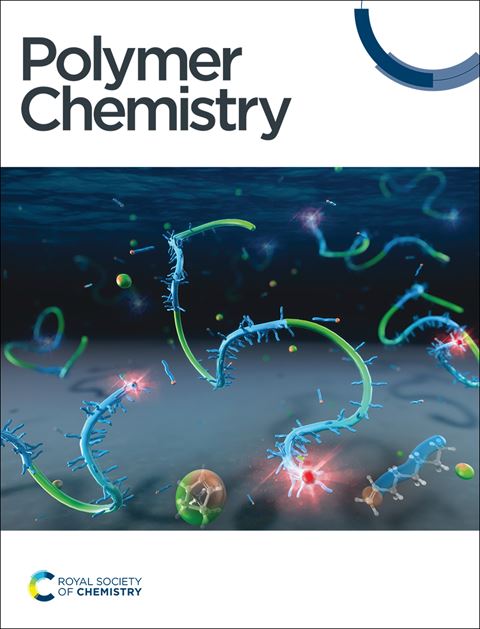空间位阻策略促进了直接芳基化聚合低成本合成聚合物PBDBT-2F及其在有机太阳能电池中的应用
IF 3.9
2区 化学
Q2 POLYMER SCIENCE
引用次数: 0
摘要
PBDBT-2F (PM6)是供-受体(D-A)偶联聚合物家族中的一员,由于其高效、通用性好,在有机太阳能电池(OSCs)中得到了广泛的应用。传统上,PM6是通过Stille偶联聚合合成的,这需要繁琐的单体预功能化。在这项研究中,我们报道了一个改进的催化体系,通过钯催化的直接芳基化聚合(DArP)合成PM6样品。通过对反应条件的优化,制备出Mn最高、PDI最低、聚集性最强的聚合物P-14,需要引入适当的位阻添加剂2,2-二乙基己酸(DEHA)。然而,聚合物结构分析表明,P-14中存在少量分支缺陷,导致π -π堆积较弱,相分离域较小。因此,与基于pm6的器件相比,P-14:IT-4F器件实现了8.90%的中等PCE, Voc更高,为0.893 V。重要的是,开发不使用胺类配体的DArP反应催化体系,进一步降低制备成本。这项工作证实了立体体策略在改善分子量和抑制缺陷方面的潜力,同时也揭示了最佳催化条件对于制备定义良好的共轭聚合物的重要性。本文章由计算机程序翻译,如有差异,请以英文原文为准。

A steric hindrance strategy facilitates direct arylation polymerization for the low-cost synthesis of polymer PBDBT-2F and its application in organic solar cells
PBDBT-2F (PM6), a prominent member of the donor–acceptor (D–A) conjugated polymer family, has attracted considerable interest for application in organic solar cells (OSCs) due to its high efficiency and excellent universality. Traditionally, PM6 is synthesized via Stille coupling polymerization, which requires tedious pre-functionalization of monomers. In this study, we report an improved catalytic system for synthesizing PM6 samples through palladium-catalyzed direct arylation polymerization (DArP). Optimization of the reaction conditions revealed that introduction of the appropriately sterically hindered additive 2,2-diethylhexanoic acid (DEHA) is necessary to prepare polymer P-14, which exhibits the highest Mn, the lowest PDI, and the strongest aggregation. However, analysis of the polymer structure indicates that a small amount of branching defects is present in P-14, leading to weaker π–π stacking and a smaller phase separation domain. As a result, the P-14:IT-4F device achieved a moderate PCE of 8.90% with a higher Voc of 0.893 V compared to the PM6-S-based device. Importantly, the development of catalytic system for DArP reactions without using amine ligands, further reduce preparation costs. This work confirmed the potential of the steric bulk strategy in improving molecular weight and suppressing defects while also revealing the importance of optimal catalytic conditions for preparing well-defined conjugated polymers.
求助全文
通过发布文献求助,成功后即可免费获取论文全文。
去求助
来源期刊

Polymer Chemistry
POLYMER SCIENCE-
CiteScore
8.60
自引率
8.70%
发文量
535
审稿时长
1.7 months
期刊介绍:
Polymer Chemistry welcomes submissions in all areas of polymer science that have a strong focus on macromolecular chemistry. Manuscripts may cover a broad range of fields, yet no direct application focus is required.
 求助内容:
求助内容: 应助结果提醒方式:
应助结果提醒方式:


